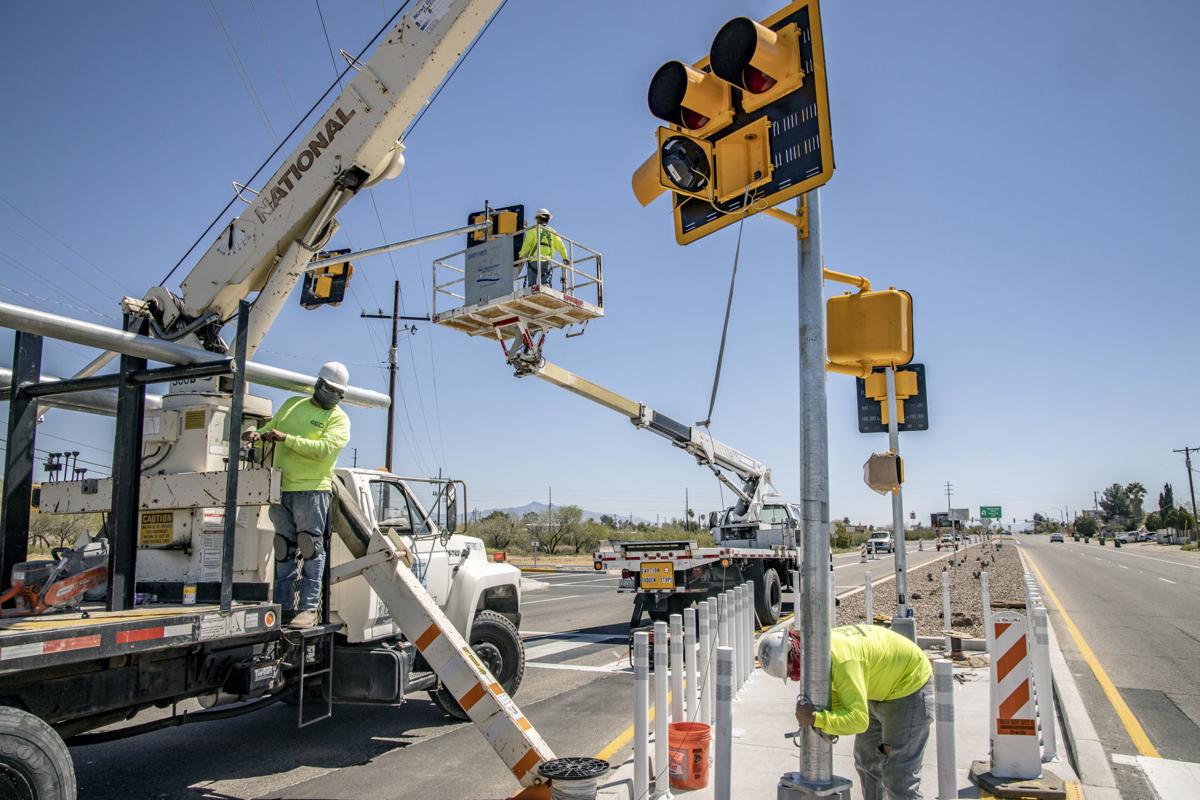As the city of Tucson continues repaving roads, its transportation department is cutting back or eliminating some marked crosswalks in the name of pedestrian safety, officials say.
While the process seems counterintuitive, data show that a crosswalk doesn’t necessarily make crossing a street safer for a pedestrian, says Diahn Swartz, the city’s traffic engineering manager.
“Under certain conditions, marking a crosswalk actually increases the risk to the pedestrian crossing the street,” she said.
That’s because pedestrians who see a painted crosswalk with no light or stop sign often assume drivers are going to stop. Drivers usually don’t, data show.
The driver compliance at those crosswalks is only 34 percent, according to a national report, Improving Pedestrian Safety at Unsignalized Crossings.
And the danger to pedestrians only increases with a higher number of lanes and volume of cars.
The city has already repaved over 1,100 miles of road with funds from Proposition 409, $100 million in street bonds approved by voters in 2012, and is continuing the work with Prop. 101 funding, a temporary half-cent sale tax increase, approved by voters in 2017, which will raise another $100 million for road repair.
But as those roads get repaved, not all crosswalks are getting repainted, such as on six-lane arterial roadways, unless the crosswalks have high use — 20 or more crossers during peak hours.
Arizona had the second-highest rate of pedestrian deaths per capita, after New Mexico, in the first half of 2018, according to the Governor’s State Highway Report, Pedestrian Traffic Fatalities by State. Pedestrian deaths are on the rise nationwide, with the surge in smartphone use over the past decade a likely contributor, the report says.
In Tucson, the number of pedestrian deaths is down from the previous two years, with at least five deaths in the first three months of 2019, according to records kept by the Tucson Police Department. There were 28 pedestrian deaths in 2018 and 25 deaths the previous year. There was an average of 14 pedestrians deaths per year over the five years prior.
While painted crosswalks do have heightened risk, the safest type of crosswalks are those with a HAWK signal — crossings where pedestrians can activate a light that turns solid red before blinking red, signaling for cars to stop.
Drivers have a 97 percent compliance rate at HAWKs, according to the national traffic report, which is slightly higher than at typical traffic signals.
But each HAWK comes with a price tag of $150,000 to $225,000, varying due to what type of work the area needs before putting in the signal.
Used nationwide, the HAWK was actually developed in Tucson in 2000 by the city’s former transportation administrator, Richard Nassi. He says back in the ’80s and ’90s, Tucson was full of flashing yellow lights, but some drivers just didn’t stop.
He says he was heartbroken over an accident in the late ’80s, when a bunch of school children were struck in a hit-and-run at such a crossing on Valencia Road.
Later, while he and his wife were on a trip to England, Nassi saw a light that became the inspiration for the first HAWK. He remembers a number of different crosswalk lights in England, and most of them were named after birds, like the pelican, toucan and puffin, Nassi said. Apparently, England even has a Pegasus crossing, which has an extra control panel high enough for people on horseback.
Nassi came back and created the HAWK, later contrived into an acronym — High-intensity Activated Crosswalk. But in its first incarnation, in the year 2000, Nassi named it the Desert Hawk. He says the first one went in where the children were hit on Valencia.
“It’s been a success story ever since,” Nassi said. “Drivers do a real good job when you’re flashing the red lights.”
Now, Tucson has 158 HAWK crossings, with more on the way. And according to city traffic officials, there hasn’t been one fatal pedestrian collision at those crossings when pedestrians use it properly .
Although there’s high demand for HAWKs, there are very few resources, Nassi said — he continues to be a consultant for the city’s transportation department. On the upside, he says Tucson’s methodology on deciding where to put HAWK crossings is one of the most progressive in the nation.
Tucson prioritizes locations based on a number of factors, with pedestrian collisions at the top. Other factors are the age of pedestrians in the area, volume of pedestrian activity, number of lanes, speed limit, road illumination, whether there’s a school nearby and whether there’s a bike boulevard.
The city supplements its list of potential HAWK locations through its own analysis or when community members ask for a HAWK.
Swartz says the city is currently using a 2018 list. When it has funding to plan more HAWKs, the city will update its current rankings, taking into consideration new factors like recent pedestrian collisions.
The city is looking for a cheaper way to build HAWKs and is fleshing out a concept for a new crossing they’re calling Baby HAWK, Swartz says.
The Baby HAWK will run on solar and cut costs where possible, such as using minimal illumination and signage while maintaining safety. City officials don’t yet know how much the Baby HAWK will cost, but it will likely be a fraction of a regular HAWK.
The truth is, the city can’t afford to put a HAWK at every crosswalk. Nassi says crossing a busy street is a risk, and the way to cut back on that risk is by everyone working together.
“The city can’t do it alone,” Nassi said. “The drivers and pedestrians have to play a major role in paying attention and being very, very careful when they cross the street.”





